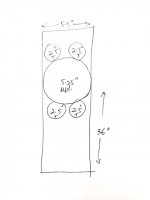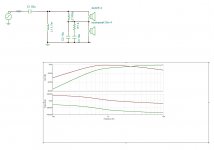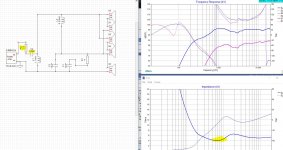This is a simulation of a 15M only on a baffle (blue) and filtered with a bandpass filter of yours, the 3.4R padding resistor included. I did my own frd and zma. Is 900 Hz where you want your woofer crossed, and 3.3 kHz for the tweeter?
Thanks, like to use your zma and frd (I copied mine from Impulse Audio's files On youtube)
I think I'd like it crossed at about 700hz with 250Hz being 4db down... or there abouts… I can eq the rest
best not to use "watts". Just use the 2.83 Volt rating
2 parallel drivers = + 6 dB
2 series drivers = + 0 dB
I see a 90 db mid with a 96 db tweeter in your setup
Im confused on your use of these drivers, can you state all crossover points of all drivers including woofer
2 parallel drivers = + 6 dB
2 series drivers = + 0 dB
I see a 90 db mid with a 96 db tweeter in your setup
Im confused on your use of these drivers, can you state all crossover points of all drivers including woofer
Last edited:
I will post the files the next day and include baffle measures of your choice. In the meantime try to gather as much information as you can regarding woofer/mid xo point, mid/tw xo point, baffle measures, driver position on a baffle, multiple tweeters can be very wrong... etc. The last sentence in post#29 I didn't get. Is the xo point 250 Hz or lower?
I will post the files the next day and include baffle measures of your choice. In the meantime try to gather as much information as you can regarding woofer/mid xo point, mid/tw xo point, baffle measures, driver position on a baffle, multiple tweeters can be very wrong... etc. The last sentence in post#29 I didn't get. Is the xo point 250 Hz or lower?
I have all same questions
best not to use "watts". Just use the 2.83 Volt rating
2 parallel drivers = + 6 dB
2 series drivers = + 0 dB
I see a 90 db mid with a 96 db tweeter in your setup
Im confused on your use of these drivers, can you state all crossover points of all drivers including woofer
For the woofers, I have a tower with four 6.5" midbass. They are basically a paradigm Monitor 100v3. I gutted out the crossover and using it as a midbass unit. Their -3db points are 400Hz and 40Hz. Below that I have a couple of 12" subs that go down to about 27Hz.
I sent the specs for the mid, its 92.5db at 2.83v. Its the only mid/bass driver with the M designation. All other are W (ie woofer). This guy (15M) is a good 2.5db more sensitive than the other drivers in the Scanspeak discovery series that are more midbass/ woofer in nature. Did you see the simulated FR I posted? Its not +6db over the mid. its quite flat.
I will post the files the next day and include baffle measures of your choice. In the meantime try to gather as much information as you can regarding woofer/mid xo point, mid/tw xo point, baffle measures, driver position on a baffle, multiple tweeters can be very wrong... etc. The last sentence in post#29 I didn't get. Is the xo point 250 Hz or lower?
Here's a rough drawing of the baffle
Attachments
Hi K amps,
When you have more than one driver, you have a boost in sensitivity from acoustic constructive inteference. So if you have 2 speaker drivers running same power, the increase is 6db. If both are running half power, it will be 3db.
If you are going down the road of DIY, it makes sense to buy a UMIK microphone and learn how to use REW, pretty cheap for $100. Will save you lots of time and work later. Or buy the Dayton setup.
Oon
When you have more than one driver, you have a boost in sensitivity from acoustic constructive inteference. So if you have 2 speaker drivers running same power, the increase is 6db. If both are running half power, it will be 3db.
If you are going down the road of DIY, it makes sense to buy a UMIK microphone and learn how to use REW, pretty cheap for $100. Will save you lots of time and work later. Or buy the Dayton setup.
Oon
I will post the files the next day and include baffle measures of your choice. In the meantime try to gather as much information as you can regarding woofer/mid xo point, mid/tw xo point, baffle measures, driver position on a baffle, multiple tweeters can be very wrong... etc. The last sentence in post#29 I didn't get. Is the xo point 250 Hz or lower?
Lojzek, see post #11: he has a 6R8 resistor on the amp's output, making it effectively the first series element (for the x/o sim).
Last edited:
For the woofers, I have a tower with four 6.5" midbass. They are basically a paradigm Monitor 100v3. I gutted out the crossover and using it as a midbass unit. Their -3db points are 400Hz and 40Hz. Below that I have a couple of 12" subs that go down to about 27Hz.
I sent the specs for the mid, its 92.5db at 2.83v. Its the only mid/bass driver with the M designation. All other are W (ie woofer). This guy (15M) is a good 2.5db more sensitive than the other drivers in the Scanspeak discovery series that are more midbass/ woofer in nature. Did you see the simulated FR I posted? Its not +6db over the mid. its quite flat.
Here's a rough drawing of the baffle
Hmmm have U tried that tweeter arraignment before?? That's a very strange tweeter array.
The simulation looks wrong to me. That tweeter wiring should give approx. +6 db over 1 tweeter. That puts tweeter sens at around 95-96 db. Even if your mid is 92-93 db that's still a high tweeter level
Hmmm have U tried that tweeter arraignment before?? That's a very strange tweeter array.
No, but I would like to try it. I have tried it in a vertical array, it has limited top to bottom dispersion. By doing this, it reduces beaming a little bit.
I agree with the +6db on the tweeters, I did not consider constructive interference, I will pad them down with a resistor or just EQ them to taste, especially in the 3k to 10k region.
Hi K amps,
When you have more than one driver, you have a boost in sensitivity from acoustic constructive inteference. So if you have 2 speaker drivers running same power, the increase is 6db. If both are running half power, it will be 3db.
If you are going down the road of DIY, it makes sense to buy a UMIK microphone and learn how to use REW, pretty cheap for $100. Will save you lots of time and work later. Or buy the Dayton setup.
Oon
Good point, I had not considered constructive interference. I might just invest in the Dayton set-up...
Lojzek, see post #11: he has a 6R8 resistor on the amp's output, making it effectively the first series element (for the x/o sim).
With good reason. As part of test hearing different components, I removed the 6r8 to see if it was causing a shift in FR, but quickly realized why I had it in the first place... the amp was not designed to be run at 4ohms... it shorted out 10 seconds... now I have a secondary issue to deal with.
yea you have a number of variables and unknowns. My advice at this point is take your own advice and get the Dayton measurement system. I use it and it works well.
Having a cheap measurement system will very quickly tell u whats really going on and will save a huge amount of frustration.
Mid band audio can go from just OK to really good with some very small changes in overall FR. The measurement system is the only way to "see" these things subtleties
Also You will likely need a 4 ohm capable amp or add resistor to mid and accept the sensitivity loss. Having a resistor on the output of amp is going to cause problems somewhere, especially in bass.
As for the tweeter array, the 4 spaced around the mid may give less vertical beaming than the 4 in a vertical line, BUT I would guess thats only because the 4 spaced around mid produces a more diffuse and less coherent wave. Not really a the best thing for image specificity and driver blending.
Having a cheap measurement system will very quickly tell u whats really going on and will save a huge amount of frustration.
Mid band audio can go from just OK to really good with some very small changes in overall FR. The measurement system is the only way to "see" these things subtleties
Also You will likely need a 4 ohm capable amp or add resistor to mid and accept the sensitivity loss. Having a resistor on the output of amp is going to cause problems somewhere, especially in bass.
As for the tweeter array, the 4 spaced around the mid may give less vertical beaming than the 4 in a vertical line, BUT I would guess thats only because the 4 spaced around mid produces a more diffuse and less coherent wave. Not really a the best thing for image specificity and driver blending.
Last edited:
You have a very particular configuration , made of 4 x100w capacity tweeters . You don't need to cut off second order but make it complimentary first order . This type of filter provides perfect addition of the sounds, specially if the tweeters are surrounding the midrange . Four tweeters in parallel serie mounted ,gets it's efficiency increased by about 6db at non beaming frequencies ,which may exceed that of the midrange. The midrange as you liked the sound , I advice you to dedicate the widest range . I adjusted 500hz ,2.5khz .
Attachments
The bass is not a problem, it has its own amplifier. Even the mids and tweets will have its own amplifier that can easily handle 2 ohm loads. I modified a Forte Audio model 3's power supplies to lower the rails from +/- 74vdc to +/- 60vdc. With 10 pairs of 1302/3281 in the outputs, it should be able to handle even 1 ohm dips with those rails. But that amp is in the HT not in my workshop. I wanted to get the basics right before I tested further. Looks like I will need to pull it out, no matter how much my back hurts lifting it 
You have a very particular configuration , made of 4 x100w capacity tweeters . You don't need to cut off second order but make it complimentary first order . This type of filter provides perfect addition of the sounds, specially if the tweeters are surrounding the midrange . Four tweeters in parallel serie mounted ,gets it's efficiency increased by about 6db at non beaming frequencies ,which may exceed that of the midrange. The midrange as you liked the sound , I advice you to dedicate the widest range . I adjusted 500hz ,2.5khz .
Thank you, very interesting and outside the box. Let me sim this on Xsim and see the FR.
You have a very particular configuration , made of 4 x100w capacity tweeters . You don't need to cut off second order but make it complimentary first order . This type of filter provides perfect addition of the sounds, specially if the tweeters are surrounding the midrange . Four tweeters in parallel serie mounted ,gets it's efficiency increased by about 6db at non beaming frequencies ,which may exceed that of the midrange. The midrange as you liked the sound , I advice you to dedicate the widest range . I adjusted 500hz ,2.5khz .
I made a couple of adjustments for better integration with the bass units with are cross off at about 250Hz. Added a 1R3 to keep impedances above 4 ohms for a bit smoother sound.
In this sim, I had to invert the polarity of the Mid, to keep phase coherence intact, is this what you had expected too?
Attachments
- Status
- This old topic is closed. If you want to reopen this topic, contact a moderator using the "Report Post" button.
- Home
- Loudspeakers
- Multi-Way
- Question on distorted sounding Inductors


